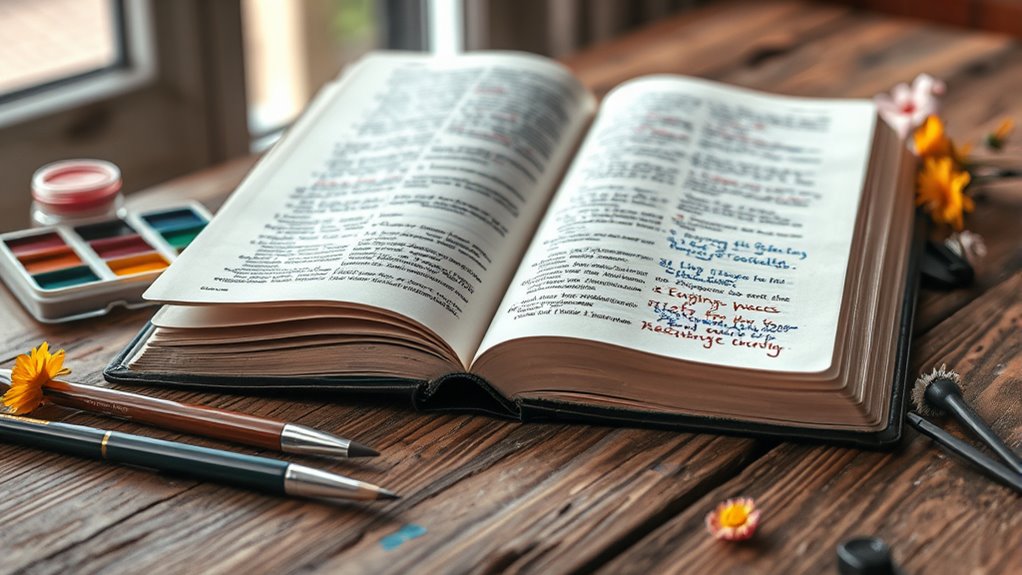Bible journaling lets you engage with scripture creatively, making your faith more personal and inspiring. Start by choosing a favorite Bible and gather supplies like pens, markers, and notebooks. Use different artistic techniques such as doodles, lettering, or color blending to highlight verses and deepen understanding. Incorporate visual storytelling and meaningful decor to reflect your spiritual insights. Keep practicing regularly to strengthen your connection with God and Scripture. Explore these ideas further to discover your creative faith expression.
Key Takeaways
- Use visual elements like doodles, sketches, and decorative lettering to enhance understanding and retention of scripture.
- Develop a consistent routine with accessible supplies to deepen engagement and spiritual growth.
- Incorporate color blending, shading, and embellishments to create visually impactful and meaningful pages.
- Reflect on verses through illustration, symbolism, and personal insights to foster a deeper connection with Scripture.
- Set clear intentions and goals for each session to make Bible journaling a purposeful spiritual discipline.
Getting Started With Bible Journaling
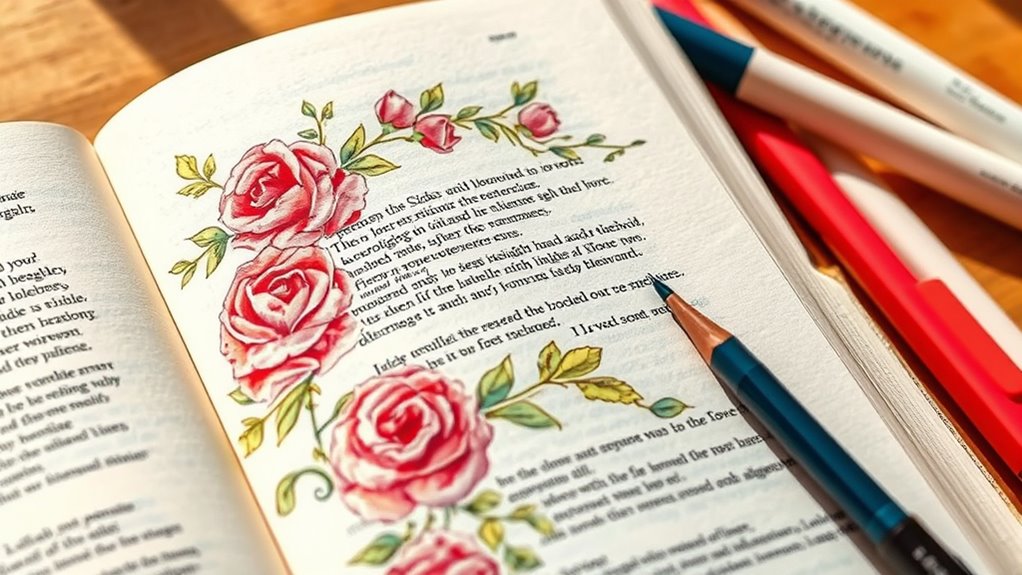
To start with Bible journaling, gather your favorite Bible, along with some supplies like pens, markers, and notebooks or journaling Bibles. Begin by reading a passage slowly, allowing your understanding through biblical interpretation to deepen. Use this time as a spiritual discipline, intentionally engaging with Scripture beyond surface reading. As you write or illustrate, reflect on how the verses speak to your life today. This process helps you internalize God’s Word and makes Scripture more meaningful. Incorporating visual elements such as doodles or sketches can enhance your connection and aid in retention. Exploring different artistic techniques can make your journaling more engaging and personalized. Additionally, utilizing creative expressions like coloring or lettering can enrich your interaction with Scripture. Developing a consistent journaling habit can foster a deeper spiritual connection and growth over time. Incorporating elements from electric bike features, such as speed or horsepower, can inspire your creative process and help you stay motivated in your spiritual journey. Over time, your journaling becomes a sacred space for both creative expression and spiritual growth. Remember, the goal isn’t just to decorate pages but to actively engage with Scripture in a way that nurtures your faith.
Choosing the Right Supplies for Creative Bible Study

Choosing the right supplies is essential for a meaningful and enjoyable Bible journaling experience. Your art supply selection should match your journaling style, whether you prefer watercolor washes, detailed pen work, or colorful highlights. Consider the type of paper in your Bible—some pages handle ink and paint better than others. Start with basic supplies like fine-tip pens, colored pencils, or water-based markers, and add more as your skills grow. Think about your preferred techniques and how much space you want to dedicate to art. The goal is to choose tools that inspire you without overwhelming. By selecting supplies that fit your style, you’ll find it easier to express your faith creatively and stay motivated in your journaling journey. Additionally, understanding the cost of building a tiny house can help you plan your budget effectively if you decide to incorporate creative space into your home. Knowing the regulations for home-based art studios can also ensure your workspace complies with local laws and safety standards. Moreover, organizing your supplies efficiently can maximize space and organization, making your creative process smoother and more enjoyable. Regularly assessing your art supply needs can help you avoid unnecessary purchases and keep your workspace clutter-free. Being mindful of storage solutions for art supplies can further enhance your ability to keep your workspace tidy and accessible.
Techniques to Enhance Your Artistic Expression
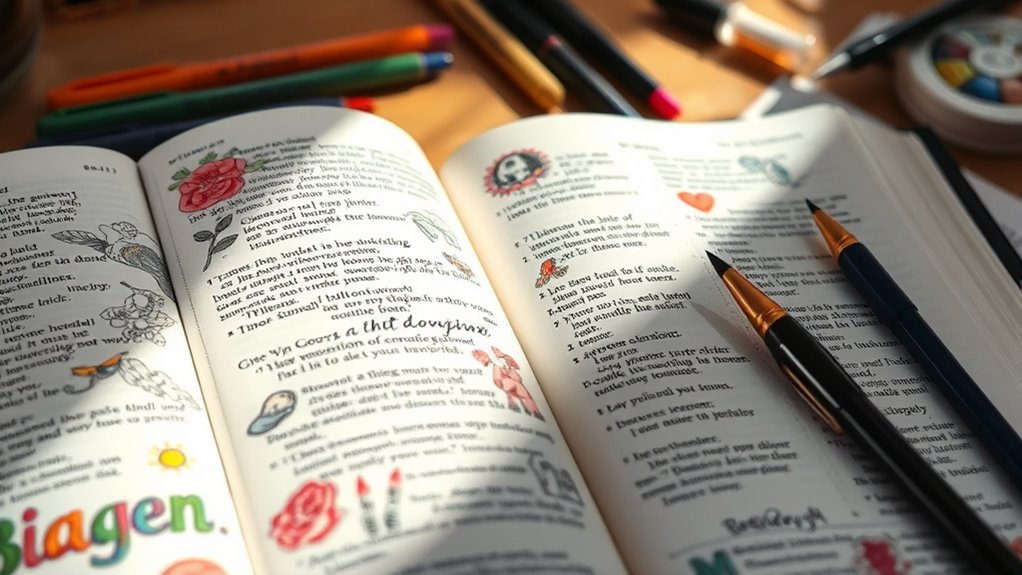
You can elevate your Bible journaling by experimenting with creative color techniques like blending and shading to add depth. Trying decorative lettering ideas, such as calligraphy or whimsical fonts, makes your entries more eye-catching. These methods help you express your faith artistically and make your journaling more meaningful. Incorporating visual storytelling techniques inspired by espionage narratives can also deepen your engagement with Scripture, especially when using narrative techniques to highlight key themes. Additionally, understanding potential security vulnerabilities can help you protect your art supplies and digital documentation from theft or damage. Being aware of environmental considerations ensures your creative process remains sustainable and eco-friendly.
Creative Color Techniques
Creative color techniques can transform your Bible journaling from simple illustrations into vibrant works of art. You can achieve depth and richness through color blending and shading techniques. Blending involves smoothly merging between hues, creating seamless color shifts that add dimension. Shading techniques, like layering darker tones, bring shadows and highlights to your artwork, making it more lifelike. Experiment with tools such as water brushes or blending stumps to soften progressions. Here’s a quick guide:
| Technique | Purpose | Tip |
|---|---|---|
| Color Blending | Smooth color transitions | Use a damp brush or sponge |
| Shading Techniques | Add depth and dimension | Layer darker shades gradually |
| Gradient Effects | Create subtle progressions | Blend multiple colors in layers |
Mastering these methods enhances your creativity with vibrant, expressive Bible journaling. Incorporating color richness can further elevate your artwork by adding visual interest and emotional impact. Exploring color techniques can help you develop a more cohesive and striking visual style. Additionally, understanding asset division laws can guide you in creating balanced and fair compositions in your artwork. Recognizing the importance of trust in your creative process can also foster confidence and resilience as you experiment with new techniques.
Decorative Lettering Ideas
Ever wondered how decorative lettering can elevate your Bible journaling pages? Exploring various calligraphy styles adds depth and personality to your reflections. Try mixing bold block letters with flowing cursive to create contrast, or incorporate lettering embellishments like swirls, banners, and floral accents. Using different pen widths and colors can make key verses stand out, guiding your focus. Practice combining simple lettering techniques with more intricate calligraphy styles to develop your unique style. Don’t be afraid to experiment with layering or adding shadow effects for dimension. These decorative elements transform plain words into visual expressions of faith, making your journaling more engaging and meaningful. Incorporating lettering embellishments such as banners and floral accents can further enhance your artistic expression. Additionally, understanding decorative lettering techniques can help you refine your skills and create more stunning pages. With a little creativity, your lettering becomes a beautiful reflection of your spiritual journey.
Incorporating Scripture Verses Into Your Artwork
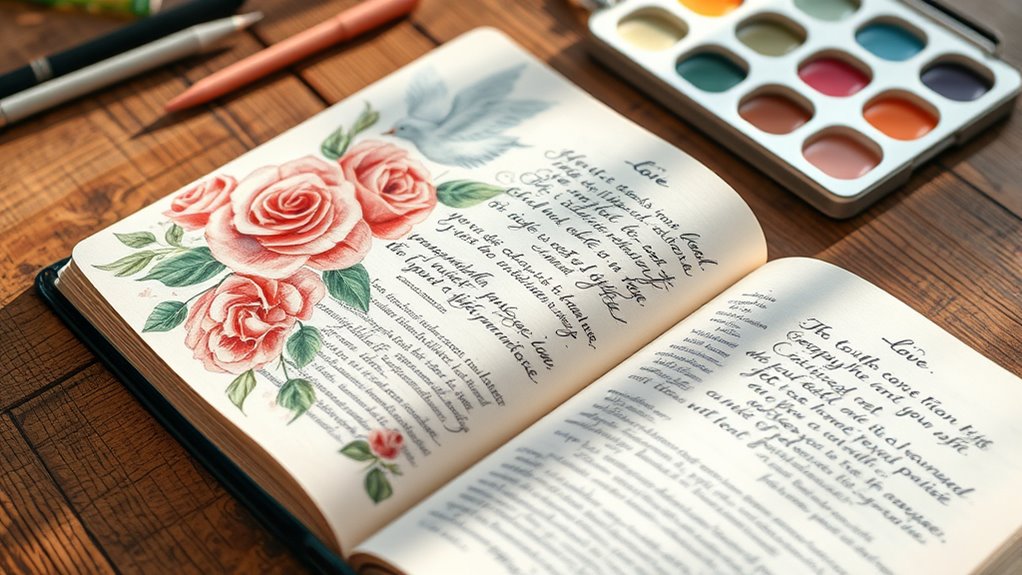
Incorporating scripture verses into your artwork brings spiritual depth and personal meaning to your journal pages. To do this effectively, experiment with different calligraphy styles that match the tone of the verse—whether elegant scripts or bold lettering—to make the words stand out. Use color blending techniques to highlight key phrases or to create a harmonious background that complements the verse. For example, soft gradients can evoke a sense of peace, while vibrant contrasts can emphasize joy or strength. Carefully choose your colors to reflect the message’s mood. When integrating scripture, keep readability in mind, ensuring your calligraphy and color choices enhance the verse’s impact without overwhelming your overall design. This approach makes your journaling both visually inspiring and spiritually enriching.
Tips for Reflective and Meaningful Journaling
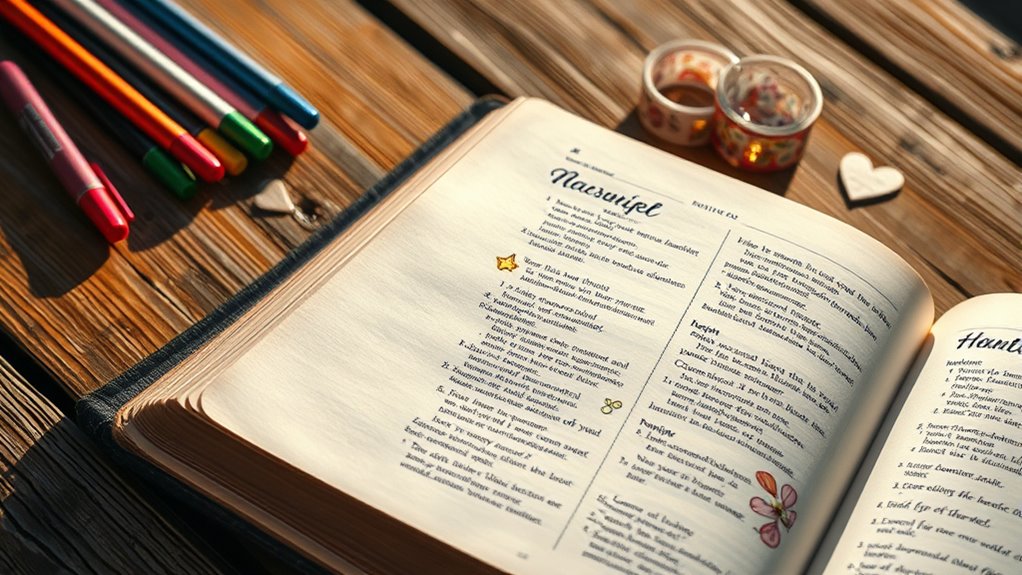
To make your journaling more meaningful, start by setting clear intentions for each session. Use creative expression to connect with the scripture and let your thoughts flow freely. This approach helps you reflect deeply and find personal significance in your work.
Set Intentions Clearly
How can you guarantee your Bible journaling remains focused and meaningful? The key is setting clear goals for each session and establishing daily routines. When you define specific intentions—whether to reflect on a verse, explore a theme, or simply connect with God—you give your journaling purpose. Consistently dedicating a set time each day helps reinforce your commitment and creates a habit that nurtures spiritual growth. By knowing what you want to achieve, you avoid drifting into aimless writing. Clear intentions keep your thoughts focused and your journaling more impactful. Remember, it’s about quality, not quantity. With purposeful goals and routines, your Bible journaling becomes a deliberate practice that deepens your understanding and engagement with Scripture. Incorporating meaningful decor can also enhance your reflective environment and inspire your spiritual journey.
Use Creative Expression
Once you’ve set clear intentions for your journaling, expressing your reflections creatively can deepen your connection with Scripture. Use visual storytelling to illustrate insights or emotions, making the scripture more vivid and memorable. Incorporate symbol exploration by drawing or adding images that represent key themes or personal meanings. This creative process helps you process and internalize God’s word more intentionally. Mindfulness techniques such as focused attention on your creative expressions can enhance your engagement and presence during journaling. Don’t be afraid to experiment with different mediums like doodles, color, or collages to convey your reflections. Creative expression transforms your journal into a personal sanctuary where your faith journey unfolds visually and emotionally. Engaging with Scripture through these artistic methods can also foster trustworthiness in your spiritual growth, making your reflections more authentic and meaningful. Utilizing portable art supplies can make it easier to incorporate creative elements into your journaling practice, especially when on the go or during travel. Incorporating visualization techniques can further deepen your understanding and emotional connection to the biblical passages you explore. Additionally, understanding the importance of local resources can help you find inspiration and support in your creative biblical journaling journey. By engaging with Scripture through these artistic methods, you nurture a more meaningful, reflective, and intimate relationship with God’s Word.
Making Bible Journaling a Regular Practice
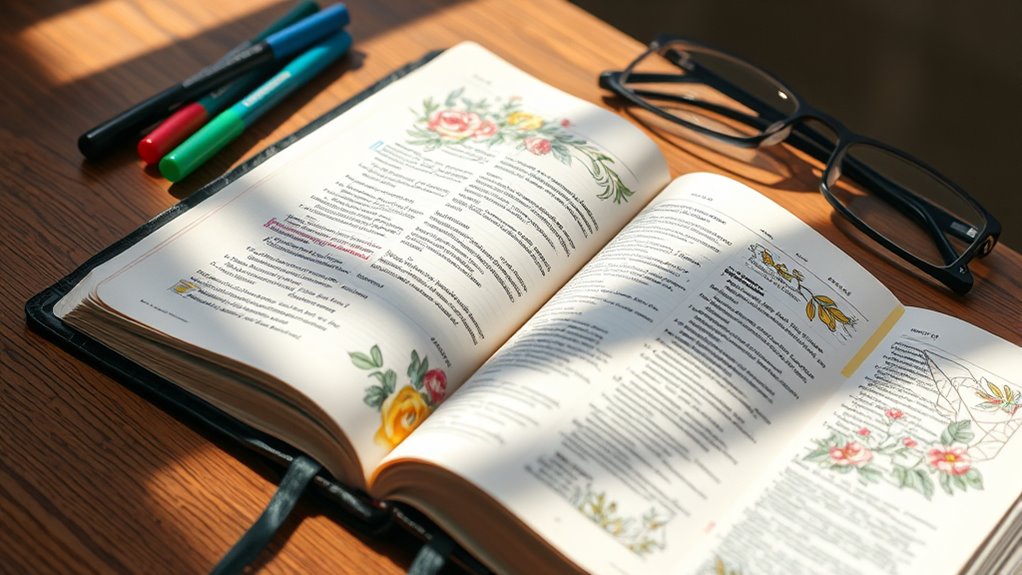
Establishing a consistent Bible journaling routine can deepen your understanding and foster a more meaningful connection with Scripture. When you make journaling a regular spiritual discipline, it becomes more than just an activity—it transforms into a essential part of your faith journey. Devotional consistency helps you stay engaged, allowing reflections and insights to deepen over time. Set aside specific times each week, whether daily or several times a week, to create a habit. Keep your materials accessible and plan simple sessions to avoid feeling overwhelmed. Soon, journaling will become an expected and rewarding part of your spiritual rhythm. Over time, this regular practice will strengthen your relationship with God and enhance your comprehension of His Word.
Inspiring Ideas to Spark Your Creativity
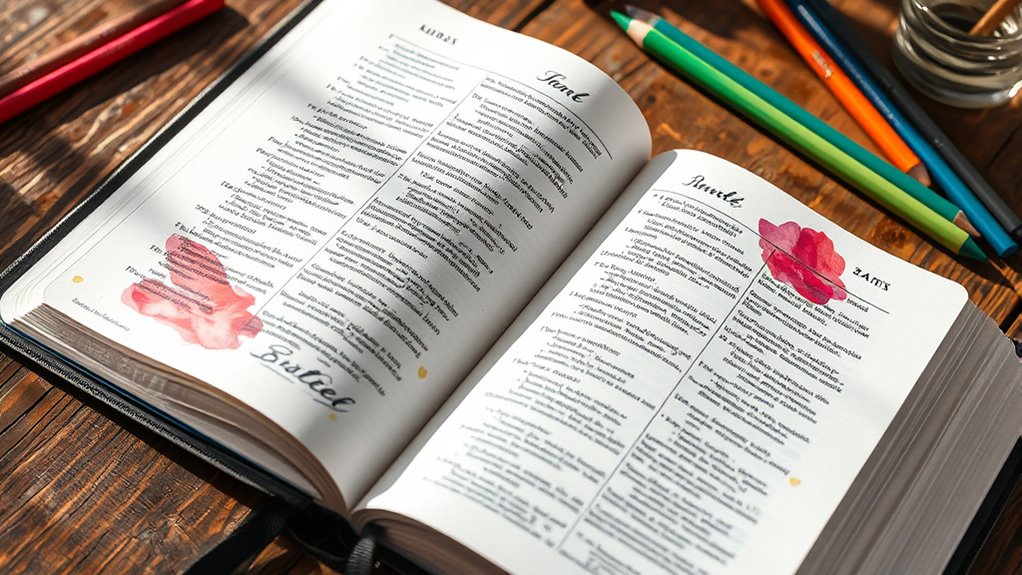
Finding fresh inspiration for your Bible journaling can reignite your passion and deepen your connection with Scripture. To spark your creativity, try using different art mediums like watercolors, colored pencils, or calligraphy to express your personal reflection. Incorporate themes from your spiritual growth journey, highlighting verses that resonate deeply with you. Explore creative techniques such as doodling margins, adding washi tape, or journaling prompts that challenge you to meditate on specific passages. Incorporating imagery or symbols related to your faith can make your pages more meaningful. Stepping outside your usual routine encourages personal reflection, helping you discover new insights and perspectives. These ideas can turn your journaling into a vibrant, reflective practice that nurtures both your spiritual growth and artistic expression.
Frequently Asked Questions
Can Bible Journaling Replace Traditional Bible Study Methods?
The current question asks if Bible journaling can replace traditional Bible study methods. While Bible journaling offers visual engagement and creative expression that deepen your connection with scripture, it shouldn’t fully replace traditional study. Instead, it complements your learning, helping you reflect more personally. Combining both approaches allows you to explore scripture with depth and creativity, enriching your spiritual journey without abandoning the solid foundation of traditional Bible study techniques.
Is Bible Journaling Suitable for Children or Beginners?
They say a picture is worth a thousand words, and Bible journaling offers colorful pages and simple techniques perfect for children or beginners. You’ll find it engaging and accessible, helping you connect with scripture creatively. This approach suits those starting their faith journey or seeking a visual way to understand God’s word. With patience and guidance, anyone can enjoy the process and deepen their relationship with scripture.
How Do I Preserve and Protect My Artwork Over Time?
To preserve and protect your artwork over time, you should use effective preservation techniques and protective materials. Store your journals in a cool, dry place away from direct sunlight to prevent fading. Use acid-free, archival-quality materials like pens, paper, and sealing sheets to avoid deterioration. Consider framing or laminating your favorite pages for extra protection. Regularly check your work to catch any signs of damage early and maintain its beauty.
What Are Some Common Mistakes to Avoid in Bible Journaling?
In bible journaling, avoid overcrowding pages, neglecting context, rushing through reflections, using incompatible supplies, and ignoring your spiritual focus. You want your pages to breathe, to tell a story, to honor the scripture. Keep your designs balanced, stay true to the message, and remember that simplicity often speaks louder than clutter. By avoiding these mistakes, you create meaningful, respectful, and beautiful reflections that enhance your faith journey.
Can Bible Journaling Be Done Digitally or Only by Hand?
You can definitely do Bible journaling digitally or by hand. Digital adaptation allows you to use various art tools on tablets or computers, making it easy to add colors, sketches, and notes without mess. Hand journaling offers a tactile experience, letting you physically connect with scripture. Both methods enhance your engagement with scripture, so choose what suits your style and resources best. Either way, you deepen your spiritual reflection creatively.
Conclusion
As you set out on your Bible journaling journey, remember that each page is a blank canvas waiting for your personal touch. Like a garden blossoming with vibrant colors, your creativity can deepen your connection with scripture and faith. Embrace the process, let your heart guide your hands, and watch how your spiritual growth flourishes alongside your artistic expression. Your journey isn’t just about art—it’s about nourishing your soul in ways words alone cannot capture.

